Ever wondered what makes mid-century modern kitchens timeless and endlessly captivating? These designs blend sleek simplicity with warm, inviting touches, making them a favorite for homeowners who crave both style and functionality. With their clean lines, iconic color palettes, and clever use of natural materials, mid-century modern kitchens continue to inspire generations, offering a perfect balance between retro charm and contemporary elegance.
In this article, you’ll discover a wealth of inspiration and practical ideas to bring that iconic style into your own space. From statement lighting and vintage-inspired fixtures to bold color choices and smart storage solutions, we’ll explore a diverse range of authentic design elements. Whether you’re a dedicated design enthusiast or just looking to refresh your kitchen, get ready to uncover ideas that will help you create a space that’s both stylish and timeless.
1. Sleek Flat-Front Cabinets with Warm Wood Finishes
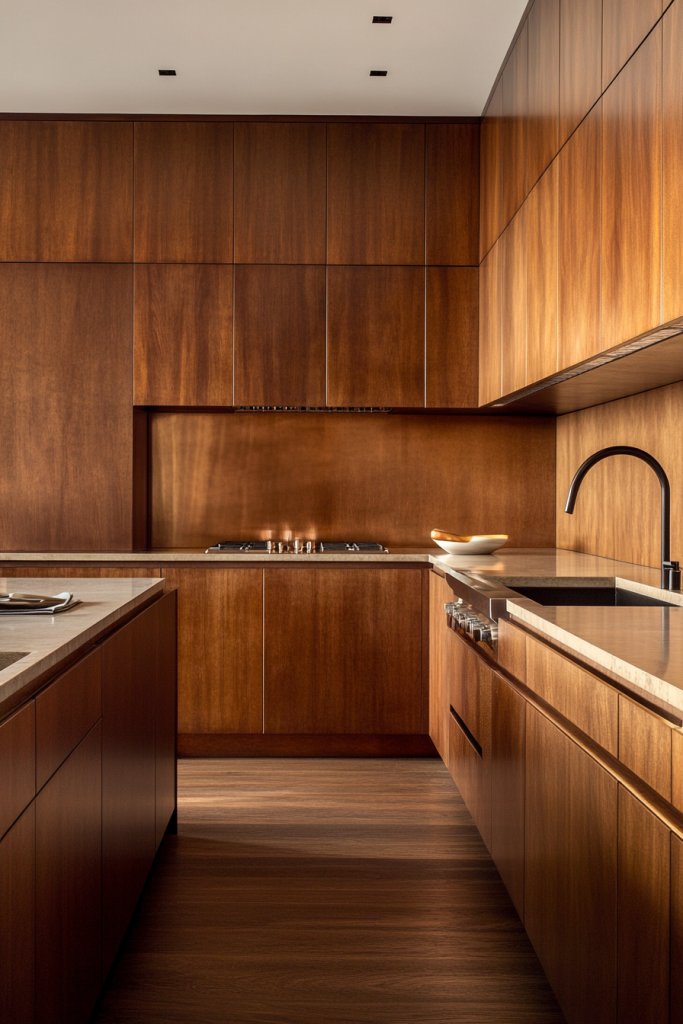
Mid-century modern kitchens often showcase sleek, flat-front cabinets that emphasize clean lines and minimal ornamentation, creating a timeless look. These cabinets are typically made from rich woods like walnut or teak, featuring warm, inviting tones that add depth and character to the space.
Their smooth, handleless surfaces contribute to an uncluttered aesthetic, making the kitchen feel more spacious and modern. Paired with subtle hardware or push-to-open mechanisms, these cabinets offer a seamless visual flow that highlights craftsmanship and natural beauty.
Imagine walking into a kitchen where the cabinetry stretches across the walls with a consistent, flat surface finished in honeyed walnut, complemented by softly textured wood grain. The warm hues contrast beautifully with cool-toned countertops, while the absence of visible handles keeps the design sleek and understated.
The tactile experience of the smooth wood invites a sense of calm, and the natural scent of polished wood adds to the sensory richness. This combination creates a cozy yet sophisticated environment perfect for both everyday cooking and entertaining.
To recreate this look, start with flat-front cabinets in a high-quality veneer or painted finish resembling warm woods like walnut or teak. Opt for handleless designs with integrated push-to-open mechanisms for a seamless appearance.
For a budget-friendly alternative, painted MDF in warm neutral tones can mimic the style. Finish with soft-close hardware to ensure quiet, smooth operation. Pair these with simple, unobtrusive countertops—marble or laminate in neutral shades—to enhance the sleek aesthetic without overwhelming the space.
2. Iconic Retro Color Palettes: Turquoise, Mustard, and Olive Green
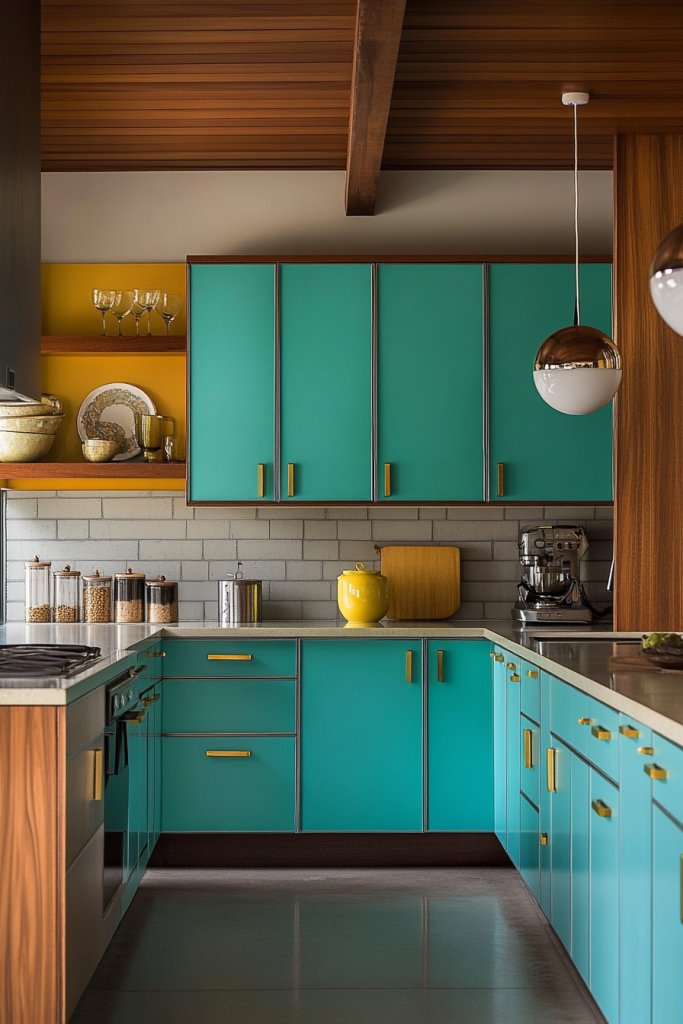
Color plays a pivotal role in capturing the spirit of mid-century modern kitchens, with vibrant, retro-inspired palettes that evoke nostalgia and personality. Bright turquoise cabinets or accent walls can instantly energize the space, paired with mustard-yellow accessories or backsplash tiles for a cheerful vibe.
Olive green, often used as an accent or in smaller details, grounds the palette with a touch of earthiness, balancing bold hues with natural warmth. These colors, used thoughtfully, create a lively, inviting atmosphere that feels both nostalgic and fresh.
Visualize a kitchen where a turquoise backsplash runs behind sleek, flat-front cabinets painted in soft beige, accented with mustard-colored barstools and a matching retro kettle. The walls are painted in a muted olive green that complements the brighter tones, adding depth and visual interest.
The color combination invites a sense of playfulness and comfort, while the glossy finishes on the ceramics and appliances reflect light, making the space feel open and vibrant. The overall effect is a cheerful, timeless aesthetic that sparks joy and conversation.
To incorporate these colors, start with a bold turquoise backsplash or wall paint as your focal point. Use mustard accents in your accessories—think vintage-style mugs, cushions, or small appliances—and sprinkle olive green through smaller decor items like dishware or textiles.
If painting walls feels too bold, consider adding colorful tiles or ceramics in these shades. For a more subdued approach, opt for cushions, curtains, or artwork that feature these hues to subtly incorporate the palette without overwhelming the space.
3. Minimalist Open Shelving for Functional Display
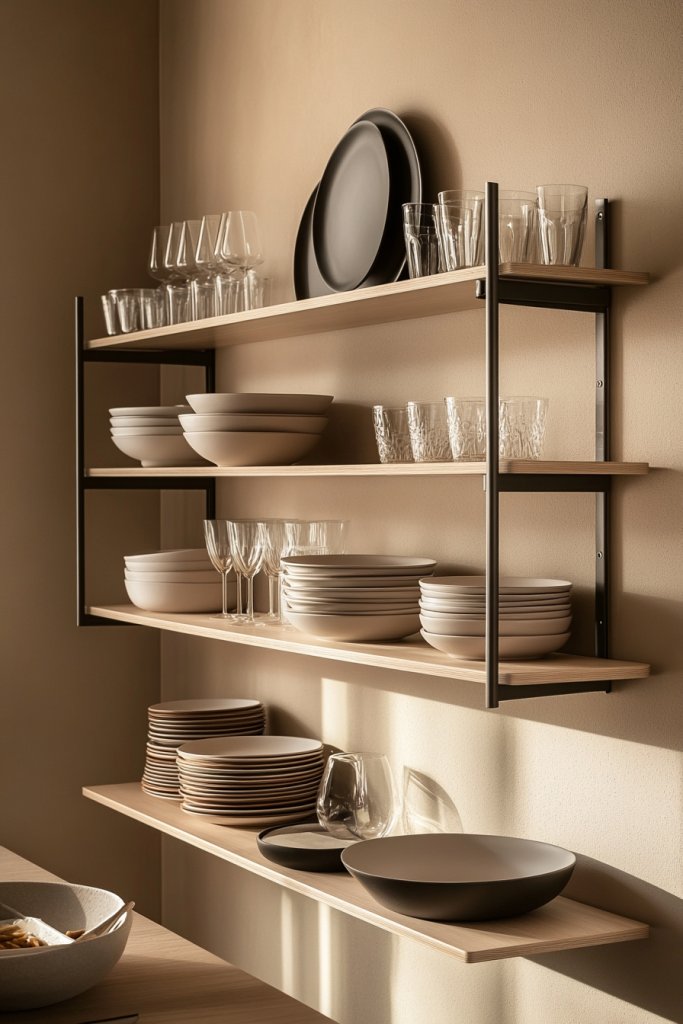
Open shelving epitomizes the mid-century modern principle of combining form and function, offering a practical way to display and access everyday essentials while maintaining a clean aesthetic. Slim, floating shelves made from wood or metal create an airy, uncluttered look that emphasizes simplicity and organization.
These shelves are ideal for showcasing beautiful dishware, glassware, or decorative objects like ceramics and vintage collectibles, adding personality without visual clutter. Picture a kitchen with a pair of floating oak shelves mounted against a crisp white wall.
On them sit a curated collection of colorful ceramic bowls, neatly stacked glass jars filled with pantry staples, and a few sculptural vases. The open design allows you to see everything at a glance, making meal prep more efficient.
The natural wood textures contrast softly with the smooth, glossy cabinets, creating a warm, inviting environment. Soft under-cabinet lighting can enhance the display, adding a cozy glow and highlighting your favorite pieces.
Getting started is simple: install floating shelves using sturdy brackets or hidden mounting hardware for a sleek look. Choose natural wood or matte black metal for a contemporary vibe.
Keep the display minimal—select a few key decorative objects or everyday dishes to avoid visual overload. Use matching or complementary dishware to create a cohesive look, and consider adding under-shelf lighting for extra warmth and functionality. This approach enhances both the style and practicality of your kitchen.
4. Statement Pendant Lighting in Geometric Shapes

Lighting is a crucial design element in mid-century modern kitchens, and statement pendant lights in bold geometric shapes serve as focal points that elevate the entire space. These fixtures often feature materials like matte metal, glass, or ceramics, with designs such as spheres, cones, or angular polygons that reflect the era’s love for clean lines and abstract forms.
Placed over islands or dining areas, they add visual interest while providing functional illumination. Envision a kitchen with a cluster of pendant lights—each with a matte black finish and geometric shapes like hexagons or elongated cones—hanging over a sleek island with a marble countertop.
The warm glow from the bulbs creates a cozy ambiance, highlighting the smooth surfaces and contrasting textures. The angular fixtures add a sculptural quality, making the lighting itself a piece of art.
The minimalist design ensures the fixtures complement rather than overpower the space, blending form with function beautifully. To achieve this look, select pendant lights with geometric frames in matte black, brushed brass, or colored glass to match your color palette.
Hang them at varying heights for a dynamic visual effect, ensuring they are proportionate to the size of your island or table. For an easy DIY option, you can repurpose or build simple geometric wireframes, or choose ready-made fixtures from mid-century-inspired collections. Keep the wiring discreet for a clean, modern appearance, and enjoy the statement they make in your kitchen’s overall design.
5. Iconic Eames-Style Dining Chairs for Seating Elegance

Eames-inspired dining chairs are quintessential symbols of mid-century modern design, combining comfort, style, and versatility. Known for their molded plastic or plywood seats with sleek, tapered legs, these chairs bring a sense of effortless elegance to any kitchen or dining area.
Their iconic silhouette adds a retro yet timeless touch, making them a favorite choice for achieving authentic mid-century style. Imagine a dining nook featuring a round table paired with a set of Eames-style chairs in black or vibrant colors like mustard or teal.
The smooth, curved seat shells are designed to cradle the body comfortably, while the slender wooden or metal legs lend a light, airy feel to the space. The chairs’ minimalist form allows them to blend seamlessly with various decor elements, from bold accent colors to neutral tones, creating an inviting yet sophisticated dining environment.
To incorporate these chairs, look for affordable replicas or vintage finds online or at thrift stores. They are easy to assemble—most come with a few simple parts—and require minimal maintenance.
Choose a durable, easy-clean plastic or plywood finish, and pair them with a simple mid-century style table, whether round or rectangular. This combination instantly injects authenticity into your kitchen’s seating area without overwhelming your budget or space, offering a stylish spot for family meals or casual gatherings.
6. Incorporating Natural Materials: Walnut, Teak, and Marble Countertops
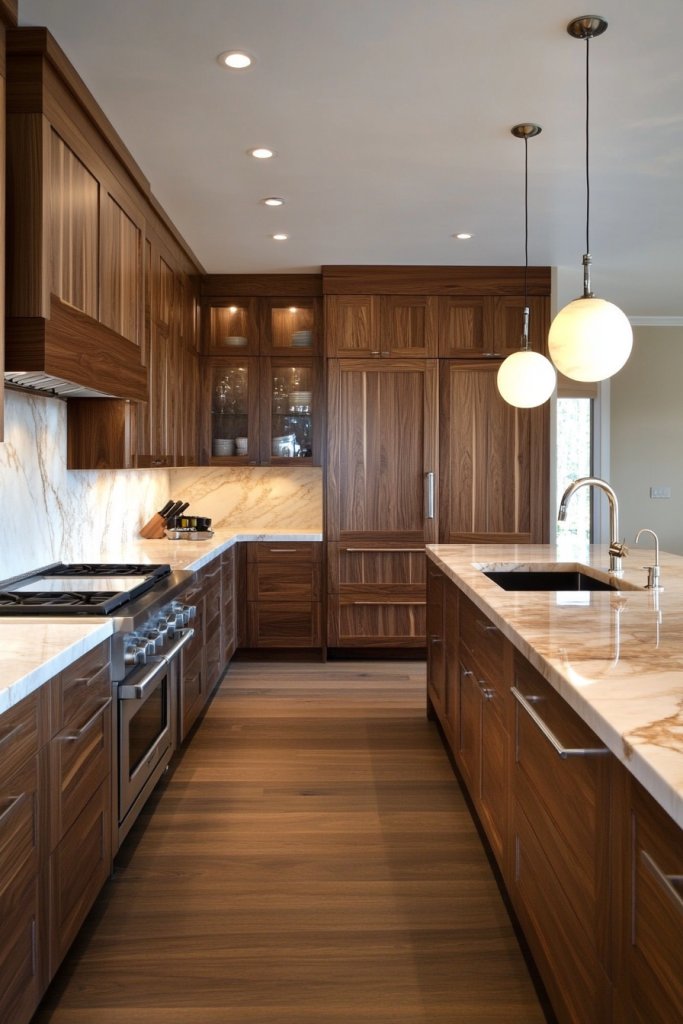
Bringing natural materials into the kitchen instantly elevates the space with a warm, authentic vibe that’s both stylish and timeless. Using elements like walnut, teak, and marble not only adds visual interest but also creates a tactile connection to nature, which is central to mid-century modern design.
Imagine a sleek kitchen with rich walnut cabinetry and a smooth marble countertop in soft whites and grays, accented by the subtle veining of the stone. Teak wood accents, perhaps in a small breakfast nook or open shelving, introduce a warm, honey-toned hue that complements the cooler marble surfaces.
The textures vary from the glossy, cool surface of the marble to the matte, grainy feel of the wood, offering a sensory experience that’s both inviting and refined. The aroma of polished wood and clean stone enhances the natural ambiance, making the kitchen feel serene and grounded.
To recreate this look, start with walnut or teak countertops — these can be pre-cut slabs or custom-fitted surfaces available at most stone and wood suppliers. Pair them with marble countertops or backsplashes, which can be sourced at tile stores or through online retailers.
For a budget-friendly alternative, quartz countertops with marble-like veining can mimic the aesthetic without the high maintenance. Finish with open shelving made of the same wood or natural stone accents for a cohesive, organic feel that’s easy to maintain and beautifully authentic.
7. Use of Retro-Patterned Backsplashes for Visual Interest
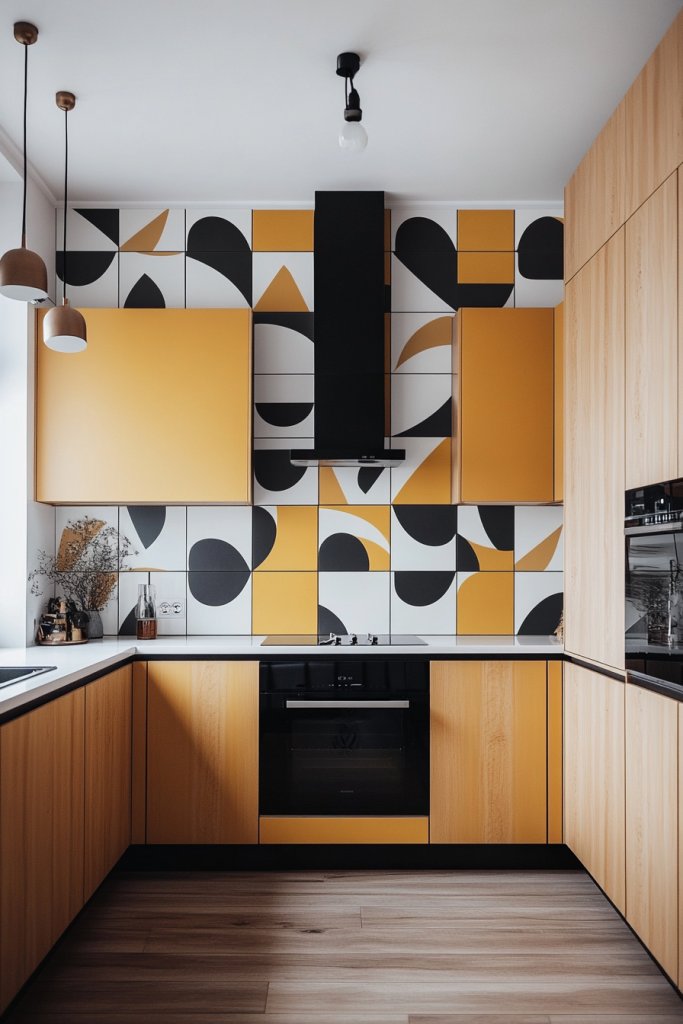
A retro-patterned backsplash is the perfect way to inject personality and visual intrigue into a mid-century modern kitchen. These patterns, often geometric or abstract, evoke the playful spirit of the era while providing a striking focal point.
Picture a backsplash composed of small tiles arranged in bold, repeating geometric shapes—think honeycomb, chevrons, or starbursts—in colors like mustard yellow, olive green, or soft turquoise. The textured surface of glazed ceramic tiles adds depth, catching the light and creating a subtle shimmer that energizes the space.
When paired with minimalist cabinetry and sleek countertops, the patterned backsplash becomes a lively yet balanced feature. The tactile quality of the tiles invites touch, and the vibrant colors evoke a cheerful, nostalgic mood that’s both timeless and modern.
To implement this idea, choose ceramic or glass tiles in geometric patterns or vintage-inspired motifs. You can find ready-made patterned tile sheets or opt for custom mosaics from specialty tile shops.
For a DIY-friendly approach, peel-and-stick tile decals with retro designs are an affordable and easy solution. Select a color palette that complements your cabinets and countertops—think mustard, olive, teal, or burnt orange—and install the tiles with standard tile adhesive and grout. Finishing with a clear sealant protects your design for years of visual enjoyment.
8. Integrated Appliances with Seamless Paneling
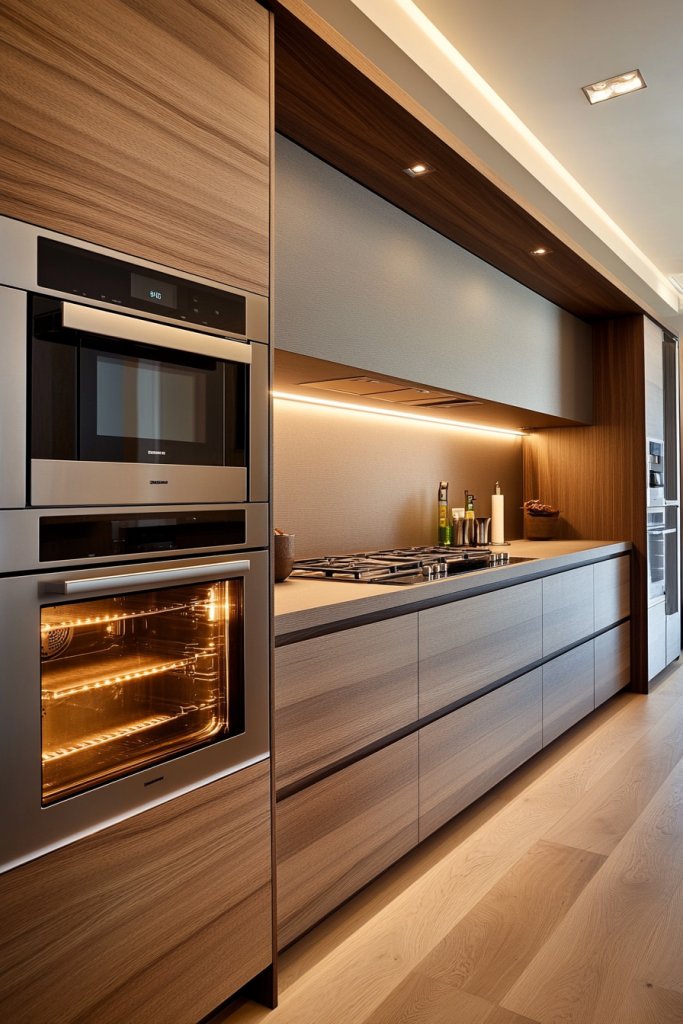
Integrated appliances are a hallmark of sleek, uncluttered mid-century modern kitchens, offering a clean, cohesive look that emphasizes form and function. By hiding appliances behind seamless panels, you maintain the minimalist aesthetic that defines this style.
Visualize a kitchen where the refrigerator, dishwasher, and oven are concealed behind cabinetry panels that match the surrounding cabinets, creating a uniform, streamlined surface. The panels are crafted from the same wood veneer or painted in a matching matte finish, blending effortlessly into the overall design.
This approach minimizes visual noise, allowing the simple geometry and elegant hardware of the cabinetry to shine. The subtlety of the integrated appliances enhances the sense of order and calm, making the space feel larger and more harmonious.
To achieve this look, select built-in appliances designed for integration, such as panel-ready refrigerators and dishwashers. Custom cabinetry with push-to-open mechanisms can eliminate handles for a sleeker appearance.
When installing, ensure proper measurements for seamless fit and use high-quality panels that match your cabinetry material. Budget-wise, you can opt for panel-ready appliances and upgrade existing cabinets with custom panels, or choose pre-finished built-ins for faster installation. The result is a kitchen that looks effortlessly stylish and perfectly cohesive, with all appliances blending into the overall design fabric.
9. Clean Lines and Simple Hardware for a Uncluttered Look

Achieving a quintessential mid-century modern kitchen is all about simplicity—clean lines, minimal hardware, and clutter-free surfaces. This approach emphasizes the beauty of the form and the materials rather than ornate details.
Visualize cabinets with flat-front doors in muted tones like soft gray or pastel shades, accented by sleek, understated hardware—perhaps slim brass or matte black pulls or even handleless push-to-open systems. The hardware, if used, is subtle and unobtrusive, allowing the cabinetry’s crisp geometry to take center stage.
Countertops are kept clear of unnecessary items, with only essential tools or decorative objects like a simple ceramic jar or a smooth wooden spoon. The overall space feels open, calm, and orderly, embodying the minimalist ethos of mid-century modern design.
To recreate this aesthetic, choose flat-front cabinets made from veneer or painted MDF, paired with discreet hardware like integrated pulls or touch-latches. For a beginner-friendly setup, opt for handleless cabinets that open with a gentle push or magnetic catches.
Keep countertops free of clutter by incorporating smart storage solutions—such as pull-out drawers or hidden compartments—that maintain the clean lines. The result is a serene, visually uncluttered kitchen that balances functionality with timeless style, perfect for everyday living and entertaining alike.
10. Use of Sculptural Mid-Century Modern Kitchen Accessories
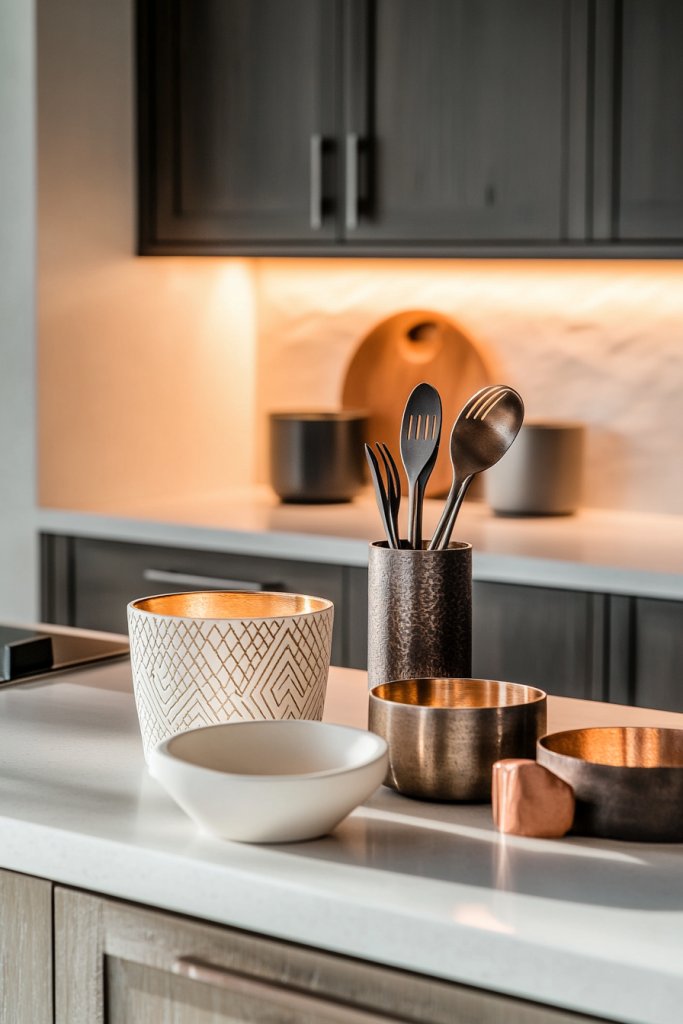
Sculptural accessories are the finishing touch that elevates a mid-century modern kitchen from functional to fabulous. These pieces add personality, texture, and a touch of artistry, serving as both decorative objects and conversation starters.
Imagine a bold, geometric ceramic fruit bowl in matte black or a handcrafted wooden sculpture placed on open shelving. You might add vintage-inspired canisters with clean lines or a statement sculpture made of brass or terrazzo.
These accessories, carefully selected, create visual interest and reflect the playful, artistic spirit of the mid-century era. The tactile quality and unique shapes of these objects introduce a sense of curated sophistication, making the space feel thoughtfully designed rather than merely functional.
To incorporate sculptural accessories, start with statement pieces like a geometric sculpture, a vintage-inspired clock, or artisanal ceramics. Look for items that contrast or complement your cabinetry and countertops—think matte black, brass, or textured ceramics.
Place these objects on open shelves, countertops, or within glass-front cabinets for a curated, gallery-like effect. Keep the arrangement balanced and intentional, ensuring each piece enhances the overall aesthetic without creating visual clutter. These accessories serve as artistic accents that bring personality and a curated, high-end feel to your mid-century modern kitchen.
11. Incorporating Vintage-Inspired Kitchen Faucets and Fixtures
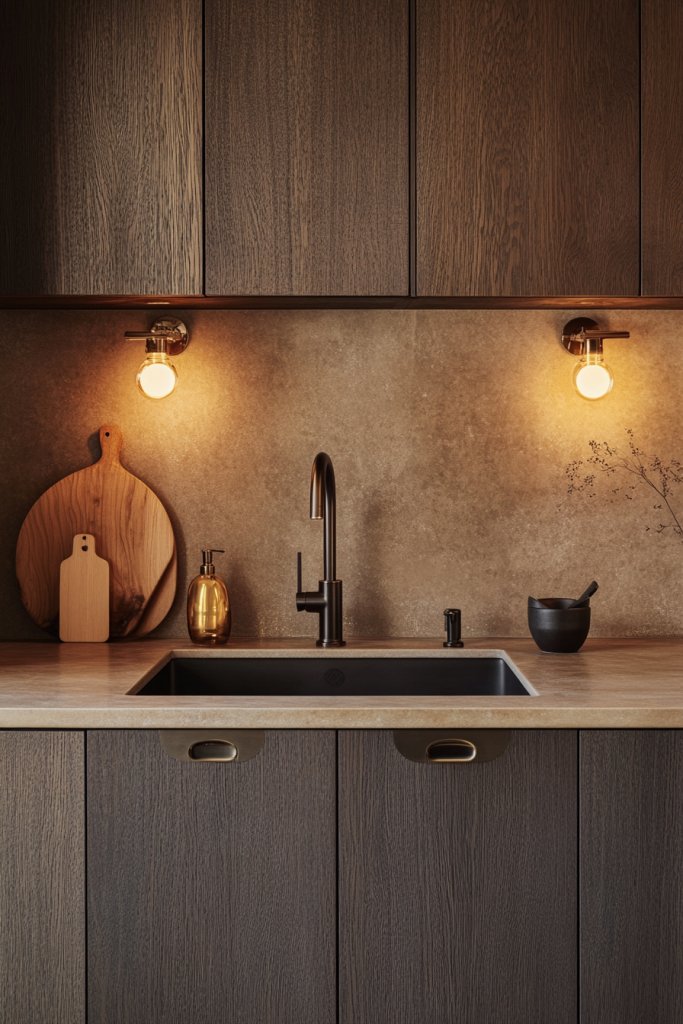
Adding vintage-inspired faucets and fixtures instantly elevates a mid-century modern kitchen, blending nostalgia with sleek functionality. These fixtures often feature rounded or sculptural shapes with polished chrome, brass, or matte finishes, creating a charming focal point amidst clean lines.
Think of a faucet with a gentle curve and a single lever or a wall-mounted fixture with a vintage feel, complemented by streamlined handles that echo 1950s design sensibilities. These elements evoke a sense of history and craftsmanship while maintaining a fresh, modern look.
Imagine a kitchen where a brushed brass faucet with a tall, arching spout sits above a white porcelain sink, paired with matching brass cabinet handles. The fixtures are smooth and tactile, with subtle detailing that catches the light, adding warmth and character to the space.
The overall aesthetic is airy and uncluttered, with the fixtures acting as statement pieces that tie together the retro color palettes and minimalist cabinetry. The atmosphere feels inviting and nostalgic, yet effortlessly modern.
To incorporate vintage-inspired fixtures, start by choosing a classic style—perhaps a single-handle faucet in brass or chrome with gentle curves. You can find affordable options at specialty hardware stores or vintage shops, or opt for modern reproductions for easier installation.
Make sure to match the finish with other hardware and accents for a cohesive look. Installing these fixtures is straightforward: remove the old, follow the manufacturer’s instructions, and enjoy the timeless charm they add to your kitchen.
12. Functional Kitchen Islands with Bold, Contrasting Colors
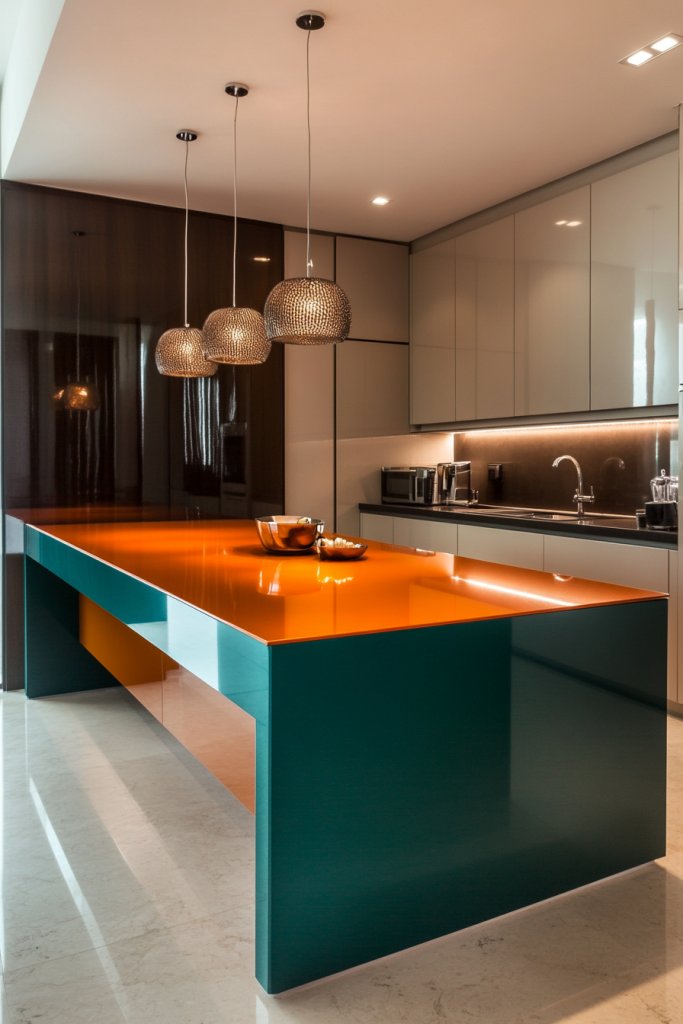
A kitchen island not only boosts functionality but also serves as a bold design statement in a mid-century modern kitchen. Opt for a sleek, rectangular shape with clean lines, and choose a striking color—such as a deep teal, sunny yellow, or rich orange—that contrasts beautifully with surrounding cabinetry.
The island’s surface can feature a natural material like marble or a durable countertop in a complementary hue, creating a focal point that energizes the space. Picture a streamlined island painted in a vibrant, matte mustard yellow, topped with a polished white marble surface that adds a touch of luxury.
The base is smooth and unadorned, emphasizing the bold color choice, while the countertop’s subtle veining adds visual interest. This island invites social interaction and practical use, with enough space for prepping, dining, or casual gatherings.
The bright color energizes the room, making it feel lively and welcoming. To implement this concept, select a sturdy base material like plywood or MDF, then paint it with high-quality, matte or semi-gloss paint in your chosen bold hue—be sure to use painter’s tape and primer for a smooth finish.
For the countertop, opt for a durable material such as quartz or marble, or even a high-pressure laminate for budget-friendly options. Finish by adding bar stools in complementary or contrasting shades, and consider minimal hardware or open shelving to keep the look sleek and open.
13. Geometric Rugs and Floor Mats to Complete the Aesthetic

A geometric rug or floor mat is the perfect finishing touch to anchor a mid-century modern kitchen, adding warmth, texture, and visual interest. These rugs often feature bold shapes like circles, triangles, or chevrons in a palette of muted earth tones, bright primaries, or pastel hues that harmonize with the overall color scheme.
Their tactile surfaces—such as low pile or flatweave—invite barefoot comfort and enhance the room’s cozy yet contemporary vibe. Visualize a low-pile rug with a repeating chevron pattern in shades of olive green and creamy white, placed beneath a dining table or in front of the sink.
The geometric shapes contrast with the sleek cabinetry and add dynamic movement to the floor. The textured surface softens the space’s sleekness while providing a visual anchor, making the room feel more inviting and balanced.
It also helps define different zones within an open-plan layout. To incorporate these rugs, measure your space carefully to select a size that complements your furniture arrangement.
Look for options made from natural fibers like wool or jute for durability and a tactile feel, or choose synthetic fibers for budget-friendliness and easier cleaning. Position the rug centrally under your dining table or in high-traffic areas, and pair it with minimalist floor mats near the sink or stove for added comfort and style.
14. Open Floor Plans Connecting Kitchen and Living Spaces
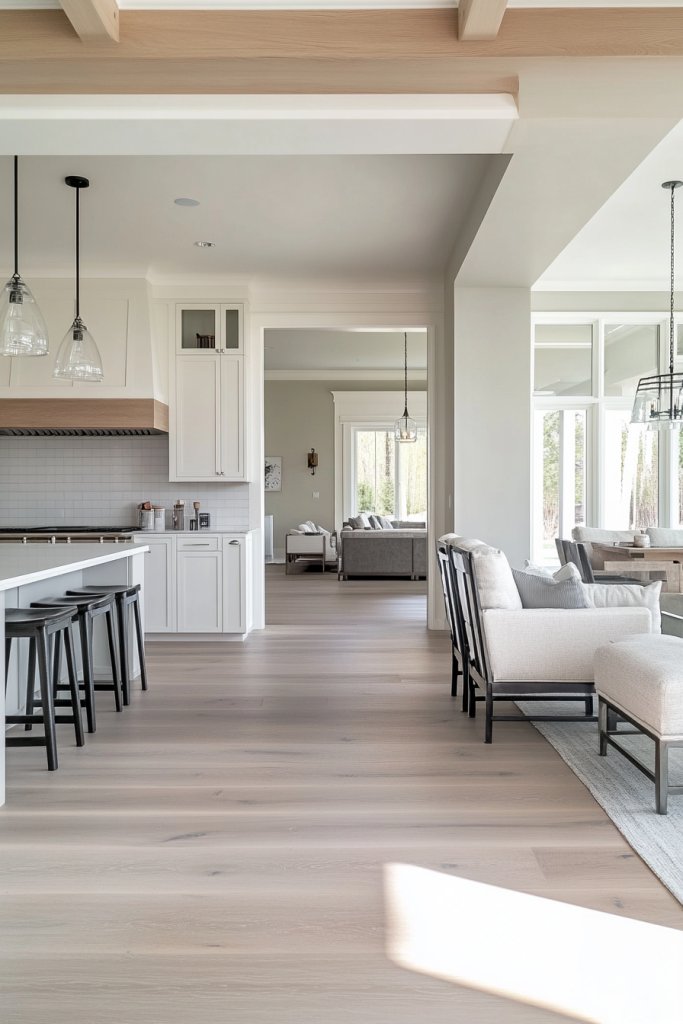
An open floor plan is a hallmark of mid-century modern design, fostering a sense of spaciousness and promoting social interaction. Removing walls or barriers between the kitchen and living areas creates a seamless flow, allowing natural light to flood the space and making it more versatile.
This layout encourages casual gatherings and makes the kitchen feel like the heart of the home, perfect for entertaining or family life. Imagine stepping into a bright, airy kitchen where the cooking area flows effortlessly into a cozy living room.
The kitchen features sleek flat-front cabinets, a bold-colored island, and minimalist open shelving, while the adjacent living space boasts a plush sofa and geometric decor. Large windows and unobstructed sightlines enhance the feeling of openness, and the consistent material palette—like warm woods and neutral tones—ties the spaces together harmoniously.
The combined area feels lively, inviting, and functional. To achieve this, consider removing non-load-bearing walls or installing partial partitions like open shelving or low cabinets to define zones subtly.
Focus on maintaining a cohesive style throughout—such as matching wood tones or color schemes—and use lighting fixtures or area rugs to delineate spaces without impeding flow. Planning the layout carefully ensures that work zones and social zones are balanced, making your home both stylish and practical.
15. Use of Glass-Front Cabinets to Showcase Classic Dishware
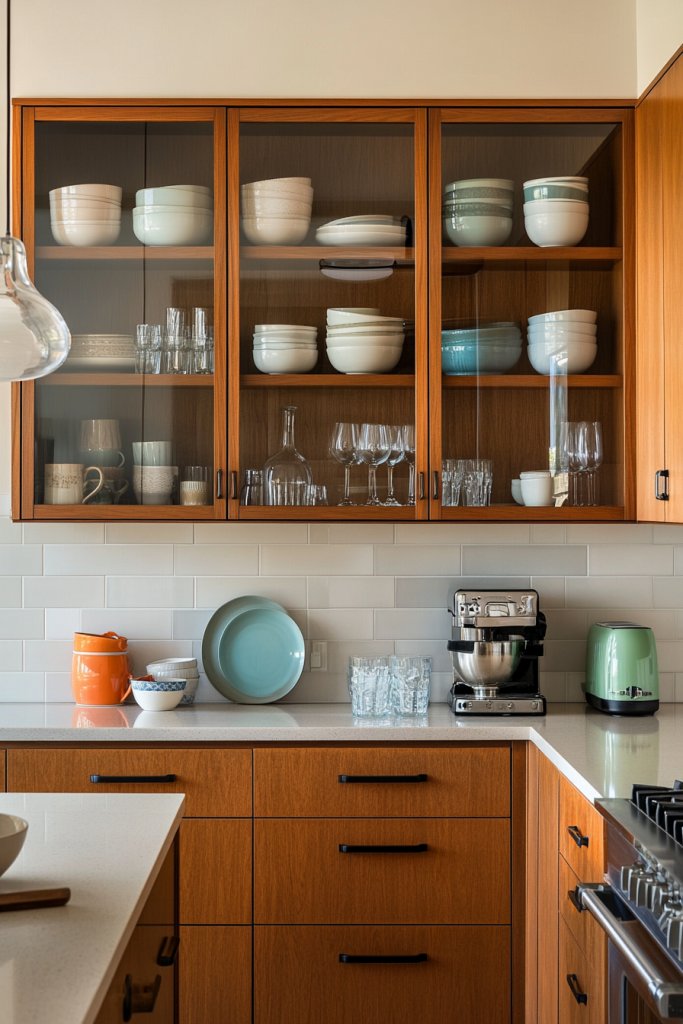
Glass-front cabinets are a quintessential feature of mid-century modern kitchens, allowing you to display your vintage dishware, colorful ceramics, or sleek glassware while keeping clutter out of sight. These cabinets add depth and visual interest, making the space feel more curated and personalized.
They also help break up solid cabinet blocks, adding a touch of transparency and lightness to the overall design. Picture a row of upper cabinets with clear glass doors, revealing neatly arranged white dishes, retro teacups in vibrant colors, or a collection of vintage glass bottles.
The contrast between the transparent glass and the solid wood or painted frame creates a striking visual element. Inside, open shelves or plate racks enhance organization, while the glass reflects light, brightening the space.
This display approach celebrates mid-century style by highlighting the beauty of functional objects. To incorporate glass-front cabinets, select doors with clear or frosted glass panels and install them into your existing cabinetry or build new units.
Use matching or contrasting hardware for a clean look. Organize your dishware neatly inside, and consider adding interior lighting for an extra touch of elegance. For budget-friendly options, retrofit existing cabinets with glass inserts or use open shelving in combination with decorative plates and cups for a similar effect.
16. Incorporating Mid-Century Modern Style Bar Stools
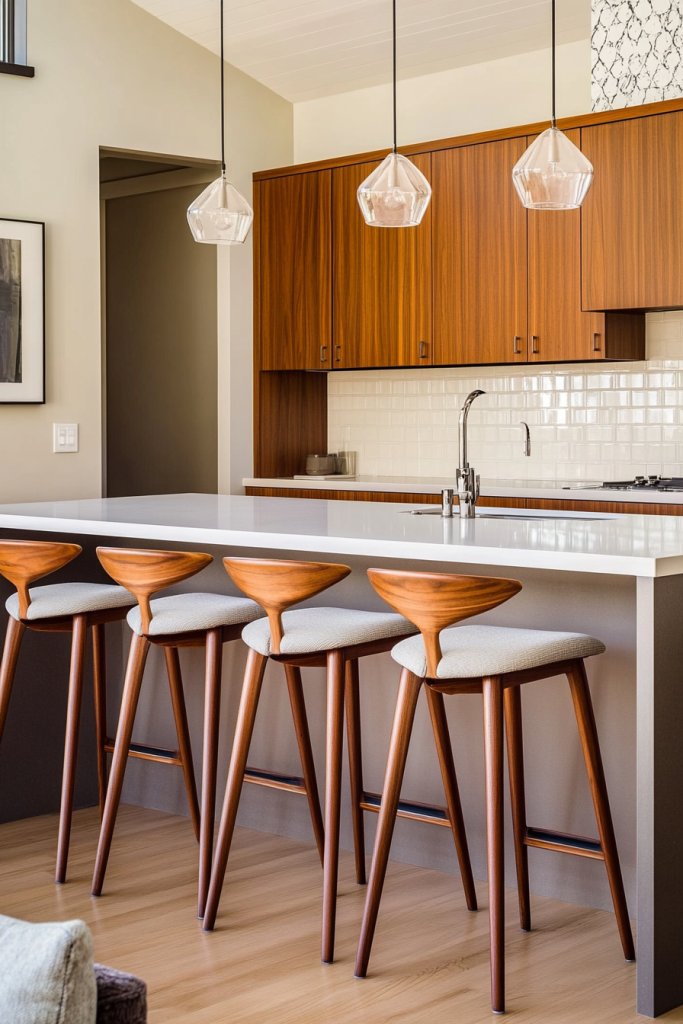
Adding vintage-inspired bar stools to your kitchen instantly evokes the charm and simplicity of the mid-century era. These stools often feature sleek, tapered legs and minimalist designs, with some showcasing gentle curves and subtle detailing.
Typically upholstered in vibrant fabrics like mustard yellow or rich teal, or finished in walnut or teak wood, they serve as both functional seating and eye-catching accents. Their proportions are just right for breakfast bars or kitchen islands, creating a cozy yet stylish gathering spot.
The overall effect is a space that feels lively, inviting, and effortlessly chic. Imagine sitting on a pair of mid-century style bar stools with smooth, rounded edges, their tapered wooden legs splayed slightly outward for stability.
The seats are upholstered in textured fabrics such as boucle or soft velvet, in bold hues like mustard or olive green, adding warmth and personality. The stools’ clean lines complement the surrounding flat-front cabinets and geometric lighting, while their natural wood finish adds a touch of organic texture.
The space feels balanced, with a nostalgic nod to the 1950s and ’60s, but with a modern twist that keeps it fresh and relevant. To incorporate these stools, start by choosing models with simple, streamlined silhouettes—look for options in walnut or teak, or with metal accents for an industrial vibe.
Pair them with a sleek kitchen island or breakfast bar, and consider adding a cushion or throw blanket for extra comfort. Assembly is straightforward, often requiring only a few screws; just ensure the height matches your counter. For a budget-friendly option, look for vintage or secondhand pieces, or consider DIY painting and reupholstering to customize your look.
17. Stylish Yet Practical Storage Solutions with Push-to-Open Doors
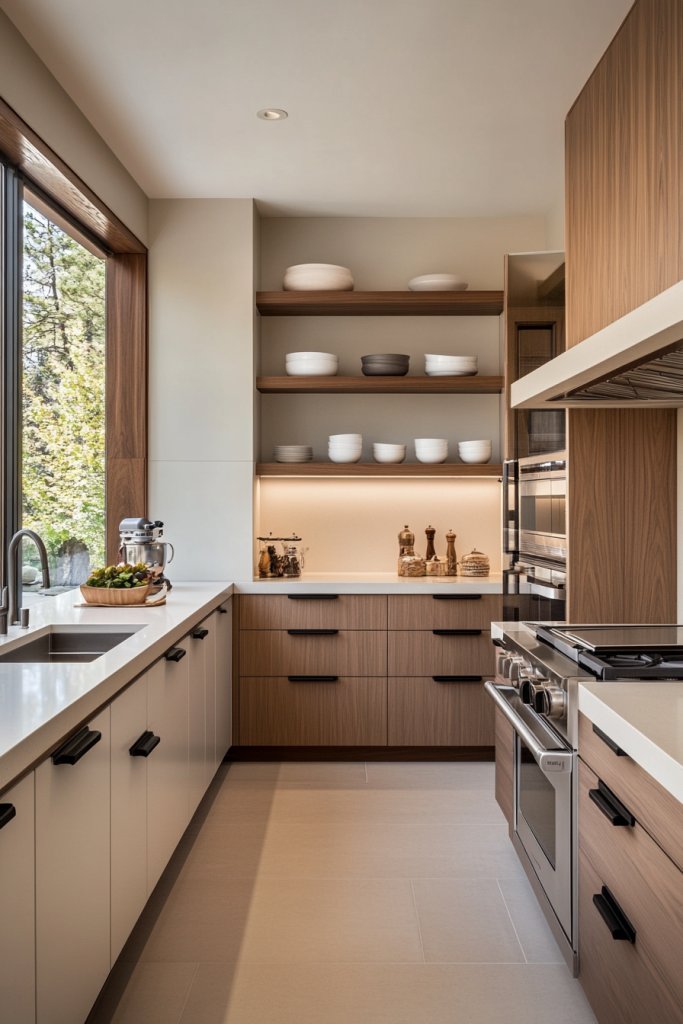
Mid-century modern kitchens thrive on clean lines and uncluttered surfaces, making innovative storage solutions a must. Push-to-open cabinet doors offer a sleek, handleless look that emphasizes simplicity and seamlessness.
These cabinets open effortlessly with a gentle press, revealing well-organized interiors perfect for storing cookware, utensils, or pantry staples. Combining this with smart shelving or hidden compartments ensures your space remains tidy while maintaining that minimalist aesthetic, making your kitchen both functional and visually striking.
Picture a row of cabinets with smooth, matte finishes in soft pastel or neutral tones, their surfaces uninterrupted by hardware. When you press lightly on the door, it pops open smoothly, revealing neatly arranged dishes, glassware, or small appliances.
Inside, adjustable shelves maximize space, and baskets or dividers keep everything in order. The push-to-open mechanism adds a futuristic touch, but it’s quietly reliable, requiring no extra maintenance.
This setup keeps your kitchen looking sleek and clutter-free, with every element serving both style and function. To implement this, choose cabinets with a push-to-open latch system—many modern kitchen retailers offer ready-made options.
For existing cabinets, retrofit with magnetic or pneumatic latch hardware, which can be installed easily with basic tools. Select durable, matte-finished cabinet doors in colors that complement your overall palette—think warm woods, muted greys, or pastel shades.
Keep the interiors organized with stackable containers, and avoid overloading for smooth operation. This approach ensures your kitchen remains effortlessly stylish and highly practical.
18. Bright, Airy Window Treatments with Minimalist Designs
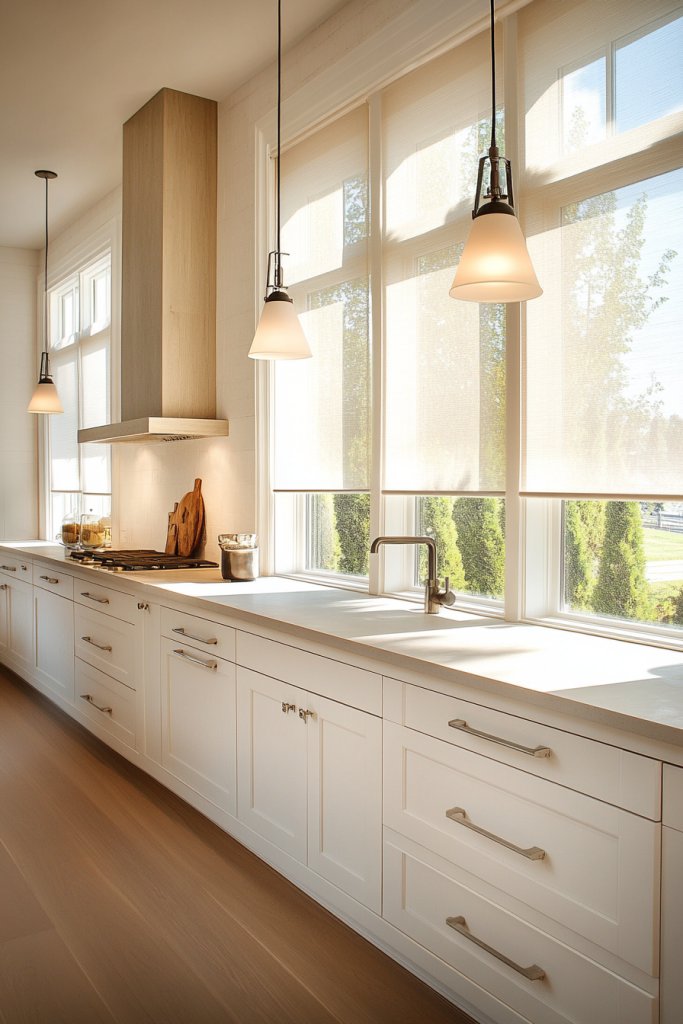
Achieving that quintessential mid-century modern look involves letting natural light flood the space while maintaining a sleek, uncluttered aesthetic. Minimalist window treatments—like sheer roller shades, simple bamboo blinds, or light linen curtains—offer just enough coverage without overpowering the design.
They soften the room’s lines, add a touch of texture, and enhance the open, airy feel that characterizes this style. These treatments also provide privacy and light control, making your kitchen both functional and visually appealing.
Visualize large, unadorned windows dressed with crisp, white linen curtains that gently drape down, creating a soft, flowing effect. Alternatively, sleek roller shades in neutral tones can be rolled up to maximize sunlight during the day, casting a warm glow over the space.
Bamboo blinds add a natural element, offering subtle texture and a hint of warmth. The overall ambiance is fresh, bright, and inviting, with the window treatments acting as a quiet backdrop to the statement furniture and fixtures.
To achieve this look, select light, breathable fabrics such as linen or cotton in neutral shades like beige, grey, or off-white. Measure your windows carefully to ensure a perfect fit, and opt for simple hardware—hidden brackets or slim rods go best with the minimalist vibe.
For easy maintenance and a contemporary finish, consider roller shades with a clean, matte finish, or install cordless options for a streamlined appearance. These treatments effortlessly blend practicality with the understated elegance that defines mid-century modern design.
19. Use of Textured Wall Panels for Added Depth
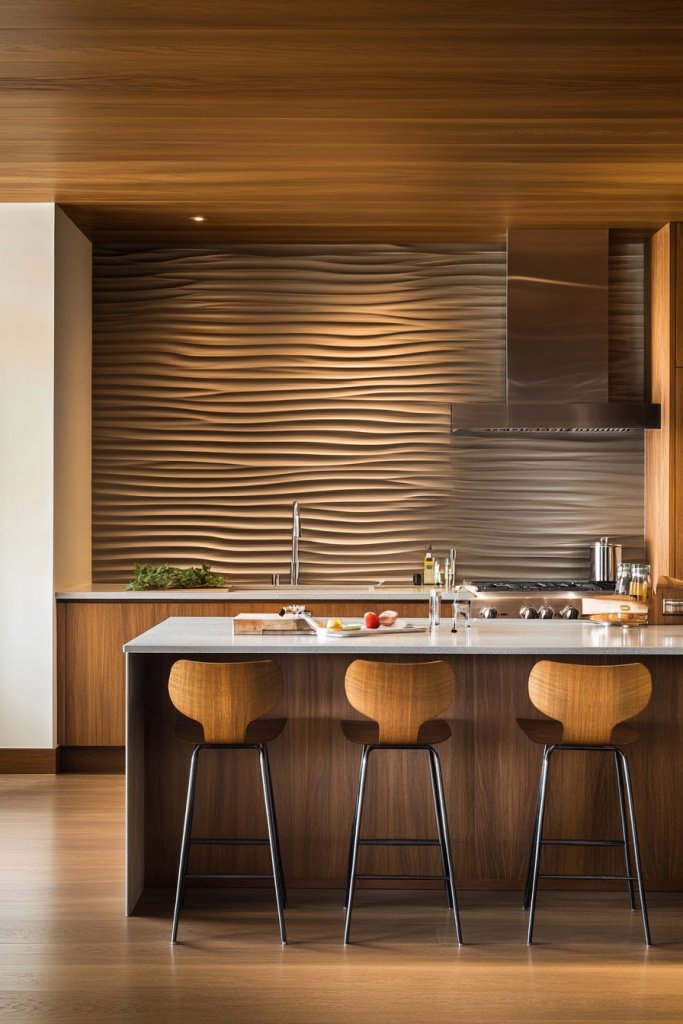
Adding textured wall panels introduces visual and tactile depth to your mid-century modern kitchen, elevating the overall aesthetic with subtle sophistication. These panels, often made from wood, metal, or molded acrylic, can be arranged in geometric patterns such as chevrons, herringbone, or grid layouts.
Their textured surfaces catch the light and cast gentle shadows, creating a dynamic focal point that enhances the room’s architectural interest. This approach adds a layer of warmth and personality without overwhelming the clean lines characteristic of mid-century design.
Imagine a feature wall behind your open shelving or backsplash area, covered in wood veneer panels arranged in a subtle herringbone pattern in rich walnut or teak tones. The texture provides a beautiful contrast to smooth cabinetry and sleek countertops, while the natural wood aroma subtly fills the space.
The textured surface also helps to disguise minor wall imperfections, making it an attractive, functional choice. The overall feel is both modern and inviting, with a tactile richness that invites touch and exploration.
To incorporate textured wall panels, start by selecting materials that suit your budget and style—wood veneer, textured wallpaper, or molded acrylic are all good options. Measure your wall carefully and decide on a pattern that complements your existing elements.
Installation is generally straightforward: adhesive and nails or screws secure panels in place. For a DIY project, consider peel-and-stick options or pre-finished panels, which simplify the process. This subtle upgrade adds character and depth, grounding your mid-century aesthetic with a cozy, layered feel.
20. Incorporating Retro-Inspired Kitchen Gadgets and Accessories
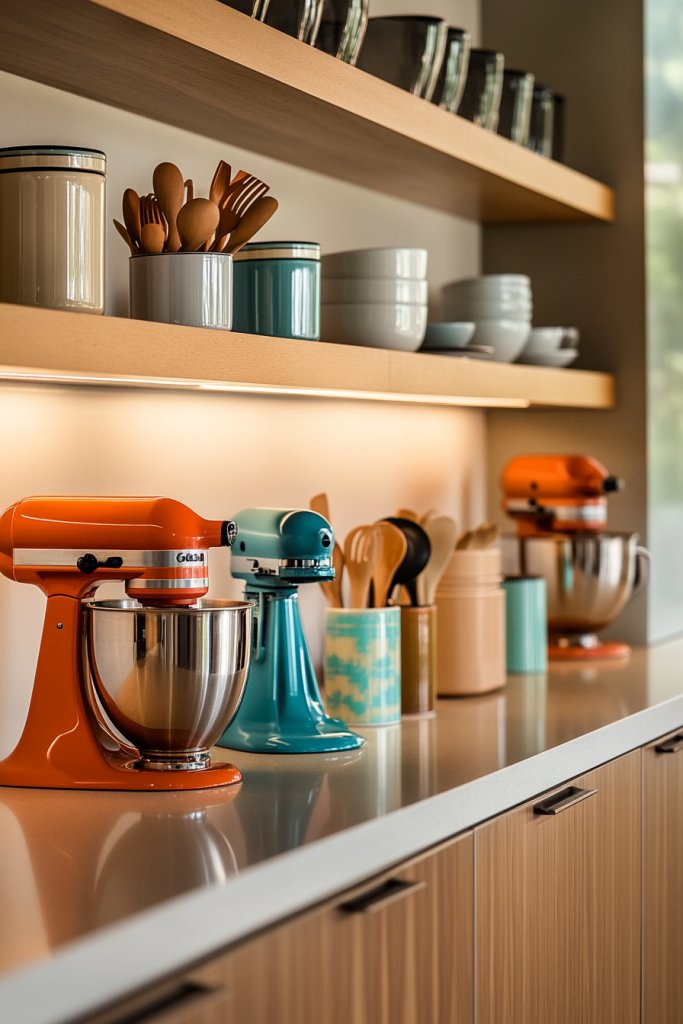
Adding retro-inspired kitchen gadgets and accessories is a fantastic way to infuse your space with authentic mid-century modern charm while showcasing your personality. These playful yet stylish touches can transform a sleek, minimalist kitchen into a vibrant, nostalgic hub that feels both functional and fun.
Imagine a countertop lined with colorful vintage toaster and retro-style canisters in shades of turquoise, mustard, or burnt orange, each piece crafted from shiny ceramic or gleaming metal. Classic handheld mixers with chromed finishes, geometric-shaped spice racks, and whimsical egg timers add visual interest and a touch of whimsy.
Textured silicone trivets, patterned dish towels with bold geometric prints, and ceramic fruit bowls in vibrant hues bring warmth and tactile appeal. The air is filled with a subtle scent of polished metal and fresh baked goods, evoking a cozy, inviting atmosphere reminiscent of the 1950s kitchen scene.
To recreate this look, start by selecting a few statement retro gadgets, such as a colorful toaster or a vintage-inspired kettle, which can often be found at antique shops or specialty online stores. Incorporate coordinating accessories like patterned dish towels, ceramic canisters, or a quirky clock with a mid-century design.
For a cohesive aesthetic, choose items in a complementary color palette—think mustard yellow, teal, or olive green—and arrange them thoughtfully on open shelves or countertops. If you prefer a simpler approach, mix and match a few standout pieces to add character without overwhelming the sleek lines of your kitchen.
21. Visual Balance with Symmetrical Cabinet and Fixture Placement

Achieving visual harmony in a mid-century modern kitchen is essential for creating a calm, cohesive space that feels thoughtfully designed. Symmetry not only enhances aesthetic appeal but also fosters a sense of order and tranquility, making the kitchen both functional and beautiful.
Imagine a kitchen where the cabinets are perfectly aligned on either side of a central island, with matching handles and evenly spaced fixtures. The upper and lower cabinets mirror each other in size and placement, while the lighting fixtures hang at equal distances, framing the space effortlessly.
Neutral tones like soft whites or warm wood shades dominate, punctuated by sleek, minimalist hardware. The overall look is balanced, with each element reinforcing a sense of stability—like a well-composed photograph.
The space feels inviting, uncluttered, and visually satisfying, emphasizing symmetry as a core principle of mid-century modern design. To recreate this, start by planning your cabinet layout so that elements are evenly spaced and aligned.
Use matching hardware—such as simple, brushed nickel knobs—and ensure fixtures like pendant lights hang at equal heights. Focus on symmetry in your appliance placement, positioning them centrally or evenly on either side.
Keep the color palette consistent across cabinets and fixtures, and consider using templates or spacers during installation to maintain precision. This approach transforms your kitchen into a balanced oasis of style and function, perfect for everyday use or entertaining.
22. Simple, Elegant Backsplash Tiles in Subtle Geometric Patterns
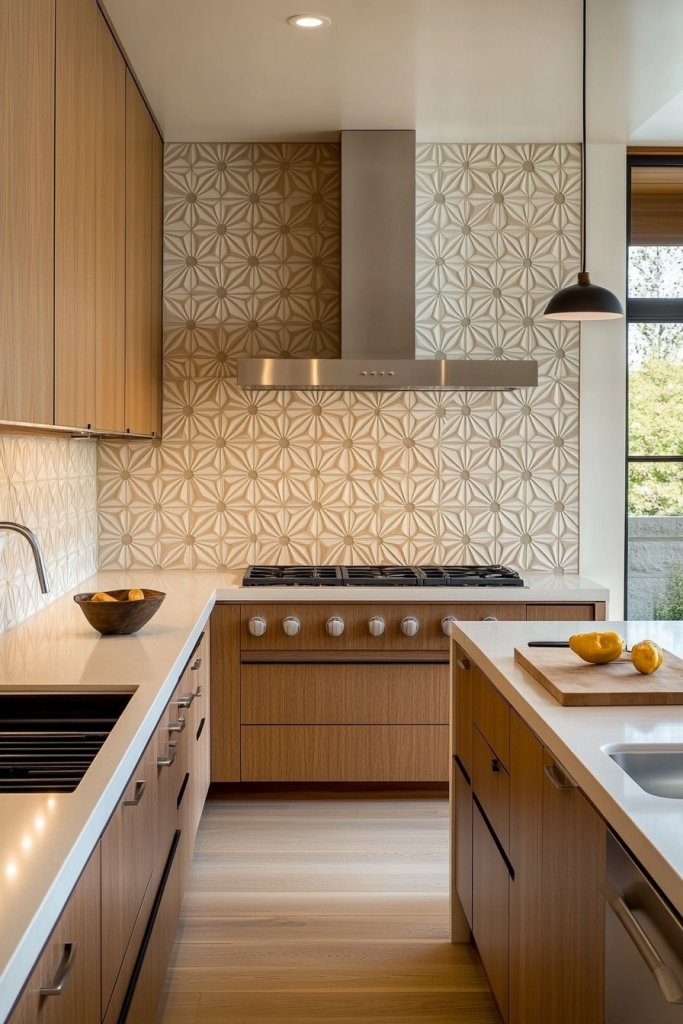
A sleek backsplash in a mid-century modern kitchen adds visual interest without overwhelming the space, especially when featuring subtle geometric patterns. These tiles serve as a refined focal point that elevates the overall aesthetic while maintaining the clean lines characteristic of the style.
Picture a backsplash composed of matte white or soft gray tiles arranged in a gentle herringbone or chevron pattern. The tiles are small, rectangular, and smooth, creating a subtle texture that catches the light differently throughout the day.
The pattern is understated but adds depth and sophistication—think of delicate zigzags or gentle waves that complement the surrounding cabinetry and countertops. The overall effect is calm, modern, and timeless, with just enough visual intrigue to keep the space lively but not chaotic.
To implement this, choose high-quality ceramic or porcelain tiles in neutral shades, and opt for subtle geometric designs like hexagons, herringbone, or linear patterns. Use a simple, matching grout to maintain a seamless look.
Prepare your wall surface by cleaning and leveling it beforehand. For DIY installation, carefully measure and plan your pattern layout before applying adhesive, and use spacers to ensure even grout lines. With a few straightforward steps, you can add a sophisticated, geometric touch that enhances your kitchen’s mid-century modern charm.
23. Mixing Matte and Gloss Finishes for Visual Contrast
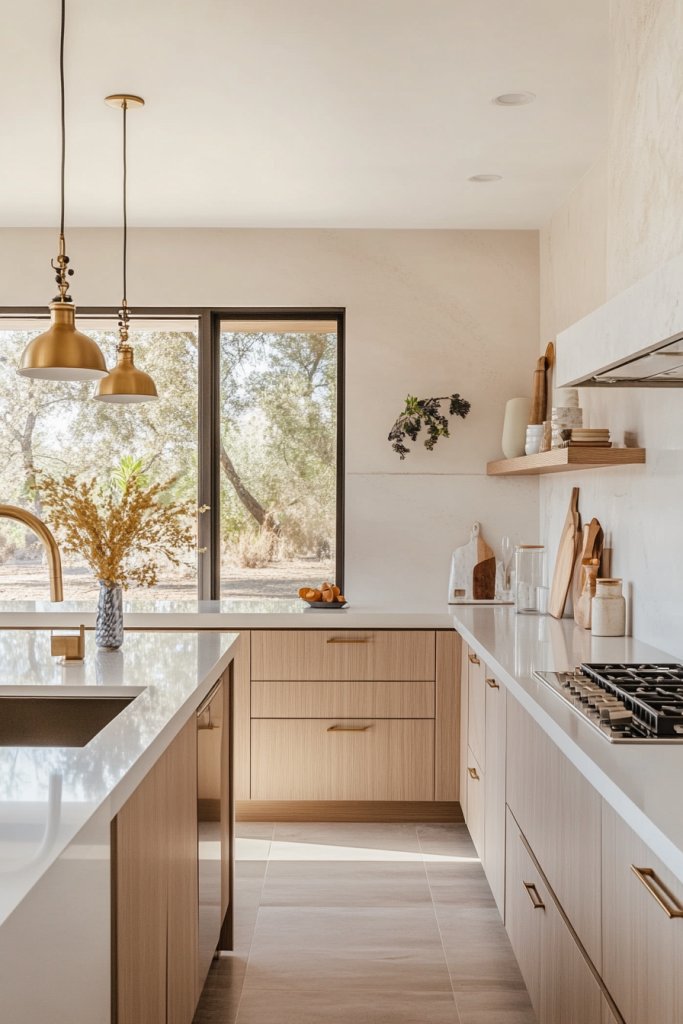
Combining matte and gloss finishes in a mid-century modern kitchen creates a dynamic visual contrast that adds depth and interest to the design. This technique highlights different elements, making the space feel layered and thoughtfully curated.
Visualize matte-finished cabinets paired with high-gloss countertops or appliances, or vice versa—glossy cabinet doors with matte hardware. The matte surfaces absorb light, offering a soft, understated look, while gloss finishes reflect light, adding brightness and a sense of polish.
This interplay of textures subtly guides the eye around the kitchen, emphasizing key design features like sleek cabinetry or shiny hardware. The overall effect is modern yet warm, with a tactile richness that invites touch and exploration.
To achieve this, select cabinets in matte finishes—such as powder-coated or lacquered surfaces—and combine them with glossy elements like ceramic tiles, countertops, or appliances. Keep the color palette consistent to maintain harmony, perhaps sticking to warm wood tones, whites, or muted pastels.
When applying these finishes, ensure surfaces are properly prepared: matte finishes require even sanding, while gloss finishes need a smooth, clean base. Incorporate this contrast carefully to avoid visual clutter, focusing on balance for a sophisticated and engaging kitchen aesthetic.
Conclusion
With so many authentic Mid-Century Modern design ideas to explore—from sleek cabinetry and vibrant color palettes to geometric lighting and vintage-inspired accessories—there’s endless potential to create a timeless, stylish kitchen that reflects your personal taste. Embrace these elements to transform your space into a warm, functional haven that celebrates both form and function.
Don’t hesitate to experiment with natural materials, bold contrasts, and clean lines for a look that remains fresh and inviting for years to come. Start infusing your kitchen with Mid-Century Modern flair today and enjoy the timeless appeal it brings to your home.
Leave a Reply